
In October, the U.S. Army hopes to select a winner for the Future Long-Range Assault Aircraft component of its Future Vertical Lift program. The Army will select Bell’s V-280 Valor or Sikorsky-Boeing’s SB-1 Defiant X as its next medium-lift rotorcraft, which will follow Bell-Boeing’s V-22 Osprey in an effort to go beyond the range and speed of traditional helicopters.
Eight years ago, I wrote here that “there are solid reasons to think [Future Vertical Lift (FVL)] will go the way of Future Combat Systems, another overambitious, ‘too-big-to-fail’ Army concept” (AW&ST June 16, 2014, p. 18). I questioned the Army’s willingness to pay a roughly 100% premium for more speed and range, thereby getting half the payload for its money. Today, though, for the Future Long-Range Assault Aircraft (FLRAA) at least, changing strategic circumstances have made the future much brighter—albeit with two caveats.
The new development is that China has emerged solidly as the greatest long-term strategic challenge to the U.S. and its allies. Russia’s war on Ukraine may be an “acute” threat, but in Pentagon parlance, China is the “pacing” threat. For the Army to be relevant in a confrontation or conflict with China and to have any hope of maintaining its share of the defense budget, it needs a new plan. The Long-Range Precision Fires concept, a network of sensors, command and missile systems designed for the Western Pacific, is the result.
But unlike the Air Force and the Navy/Marine Corps, the Army depends on the other services for deployment. The Army cannot buy ships and jets, and the service's inventory of 4,500 rotorcraft is largely irrelevant for Pacific operations due to range. The FLRAA is needed for an organic deployment capability. Budget concerns no longer matter, nor will the Army question why it should pay twice what a Sikorsky UH-60 Black Hawk costs for the same payload, just to get range and speed.
Now the caveats. Given the FLRAA unit and operating costs, it is also likely that the Army will operate a mixed fleet: 400-500 FLRAA for missions requiring range and speed and another 1,000+ Sikorsky UH-60s for traditional medium-lift roles.
The broader rotorcraft market will reflect this reality, as most customers will continue to buy much less expensive models. For an interesting precedent, go back 30 years, to the start of the V-22 program. Once, tiltrotors promised a new way to fly. The plan was to scale tiltrotors into several size classes for military roles, including a quad model in the Lockheed C-130-size class. The plan was also to develop civil and commercial variants, even for regional airline operations.
Instead, the market supported production of just over 500 V-22s for four customers—the U.S. Marines, Navy and Special Operations Command and Japan. The small, niche Leonardo AW609 may eventually arrive, after many years of delays, for the civil market, and it would mark the end of the tiltrotor “revolution” unless the V-280 wins the FLRAA contest.
That does not mean the FLRAA program numbers will be insignificant. There is an excellent chance that the Marines will buy into the program, particularly if the V-280 wins. Other customers will join, too. But at the V-22 production peak in 2010-15, deliveries represented just 16% of the military market by value. Tiltrotors promised a new way to fly; they became a high-end niche product that met a strategic need. The FVL will follow the same path.
Second, risk remains. The FLRAA and everything else the Army is planning for Pacific operations will not really come online for another decade. By that time, China and the West and its Pacific allies might have mended relations. Or China might have diminished as a threat for economic, demographic or other reasons. Or, horribly, conflict between China and the U.S. and its allies might have already happened. Alternatively, Russia could easily remain a serious menace, forcing the U.S. to return its attention to a part of the world where range and payload matter much less from an Army standpoint.
In a very different world where the Pacific is not the primary focus, the FLRAA and FVL might still appeal to the Army and other services, but a diminished rationale—and a smaller defense budget—would mean less prioritization and greater risk of cancellation. The same thing happened to the Army’s Boeing-Sikorsky RAH-66 Comanche in the aftermath of the Cold War. It was designed for circumstances and budgets that simply went away.
In short, strategic change has put the FLRAA in a very strong place right now. But circumstances could easily change again.


